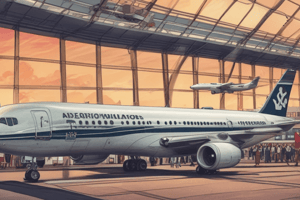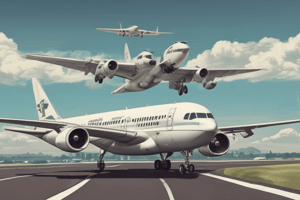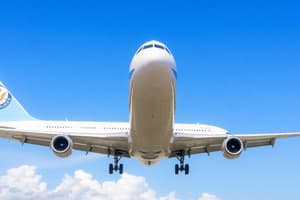Podcast
Questions and Answers
What is the primary function of the Federal Aviation Administration (FAA)?
What is the primary function of the Federal Aviation Administration (FAA)?
- To develop new aerospace technologies
- To manage global air traffic control systems
- To issue pilot licenses worldwide
- To regulate aviation safety and enforce regulations in the US (correct)
Which regulation pertains specifically to pilot certification standards in the US?
Which regulation pertains specifically to pilot certification standards in the US?
- Part 25
- Part 61 (correct)
- Part 91
- Part 23
Which of the following is a key feature of a Safety Management System (SMS)?
Which of the following is a key feature of a Safety Management System (SMS)?
- Proactive identification of hazards (correct)
- Strict adherence to regulations without flexibility
- Emphasis on post-incident reporting
- Reactive hazard assessment
What technique is commonly used during accident investigations to identify root causes?
What technique is commonly used during accident investigations to identify root causes?
What is one of the primary roles of certified maintenance organizations (CMOs)?
What is one of the primary roles of certified maintenance organizations (CMOs)?
Which regulatory body is responsible for global aviation safety standards?
Which regulatory body is responsible for global aviation safety standards?
What is a common method used to enhance teamwork and communication among pilots?
What is a common method used to enhance teamwork and communication among pilots?
What regulation focuses on airworthiness standards for US aircraft?
What regulation focuses on airworthiness standards for US aircraft?
What is one significant benefit of implementing Automatic Dependent Surveillance–Broadcast (ADS-B)?
What is one significant benefit of implementing Automatic Dependent Surveillance–Broadcast (ADS-B)?
Which action can regulatory authorities take for violations of aviation regulations?
Which action can regulatory authorities take for violations of aviation regulations?
Flashcards are hidden until you start studying
Study Notes
Aviation Regulations
-
Regulatory Bodies:
- Federal Aviation Administration (FAA) in the US.
- European Union Aviation Safety Agency (EASA) in Europe.
- International Civil Aviation Organization (ICAO) globally.
-
Key Regulations:
- Title 14 of the Code of Federal Regulations (CFR) in the US.
- Airworthiness Standards (Part 23, Part 25).
- Pilot certification standards (Part 61).
- Operations specifications (Part 91).
-
Certification Processes:
- Type certification for aircraft.
- Production certification for aircraft manufacturers.
- Operational certification for airlines and air operators.
-
Compliance and Enforcement:
- Inspections by regulatory authorities.
- Enforcement actions for violations (fines, license revocation).
- Reporting mechanisms for safety issues (Mandatory Occurrence Reporting).
Aviation Safety
-
Safety Management Systems (SMS):
- Framework for managing safety risks.
- Emphasis on proactive identification of hazards.
- Continuous improvement through data analysis.
-
Accident Investigation:
- Conducted by agencies like the National Transportation Safety Board (NTSB).
- Use of the "5 Whys" technique to identify root causes.
- Recommendations for safety improvements based on findings.
-
Pilot Safety:
- Importance of training and recurrent checks.
- Crew Resource Management (CRM) to enhance teamwork and communication.
- Use of simulators for emergency preparedness.
-
Aircraft Maintenance:
- Regular inspections and adherence to maintenance schedules.
- Use of certified maintenance organizations (CMOs).
- Importance of keeping accurate maintenance records.
-
Technological Advances:
- Implementation of Automatic Dependent Surveillance–Broadcast (ADS-B).
- Use of new materials and designs for improved safety.
- Development of advanced avionics and navigation systems.
Aviation Regulations
-
Regulatory Bodies:
- FAA oversees aviation in the US.
- EASA regulates aviation safety in Europe.
- ICAO establishes international aviation standards.
-
Key Regulations:
- Title 14 of CFR governs aviation operations in the US.
- Airworthiness Standards ensure aircraft safety (Parts 23 and 25).
- Part 61 lays out pilot certification requirements.
- Part 91 defines operational specifications for general aviation.
-
Certification Processes:
- Type certification for validating aircraft design and safety.
- Production certification for aircraft manufacturers ensuring consistent quality.
- Operational certification required for airlines and air operators to conduct services.
-
Compliance and Enforcement:
- Inspections by authorities ensure adherence to regulations.
- Enforcement actions can include fines or revocation of licenses for violations.
- Safety issues are reported through Mandatory Occurrence Reporting systems.
Aviation Safety
-
Safety Management Systems (SMS):
- SMS provides a structured approach to managing safety risks.
- Focus on proactively identifying potential hazards.
- Continuous improvement supported by data analysis for better safety outcomes.
-
Accident Investigation:
- Investigations typically conducted by the NTSB to determine causes of accidents.
- Utilizes the "5 Whys" technique to drill down to root causes.
- Findings lead to recommended safety improvements to prevent future incidents.
-
Pilot Safety:
- Emphasizes the importance of thorough training and regular performance checks.
- CRM enhances teamwork and communication among flight crews.
- Simulators are essential tools for preparing pilots for emergency situations.
-
Aircraft Maintenance:
- Regular inspections are crucial to ensure aircraft safety and compliance.
- Certified Maintenance Organizations (CMOs) perform necessary maintenance.
- Accurate records of maintenance tasks are vital for tracking aircraft safety history.
-
Technological Advances:
- ADS-B improves aircraft tracking and enhances situational awareness.
- New materials and designs contribute to overall aircraft safety.
- Advanced avionics and navigation systems modernize aircraft operation and safety protocols.
Studying That Suits You
Use AI to generate personalized quizzes and flashcards to suit your learning preferences.




